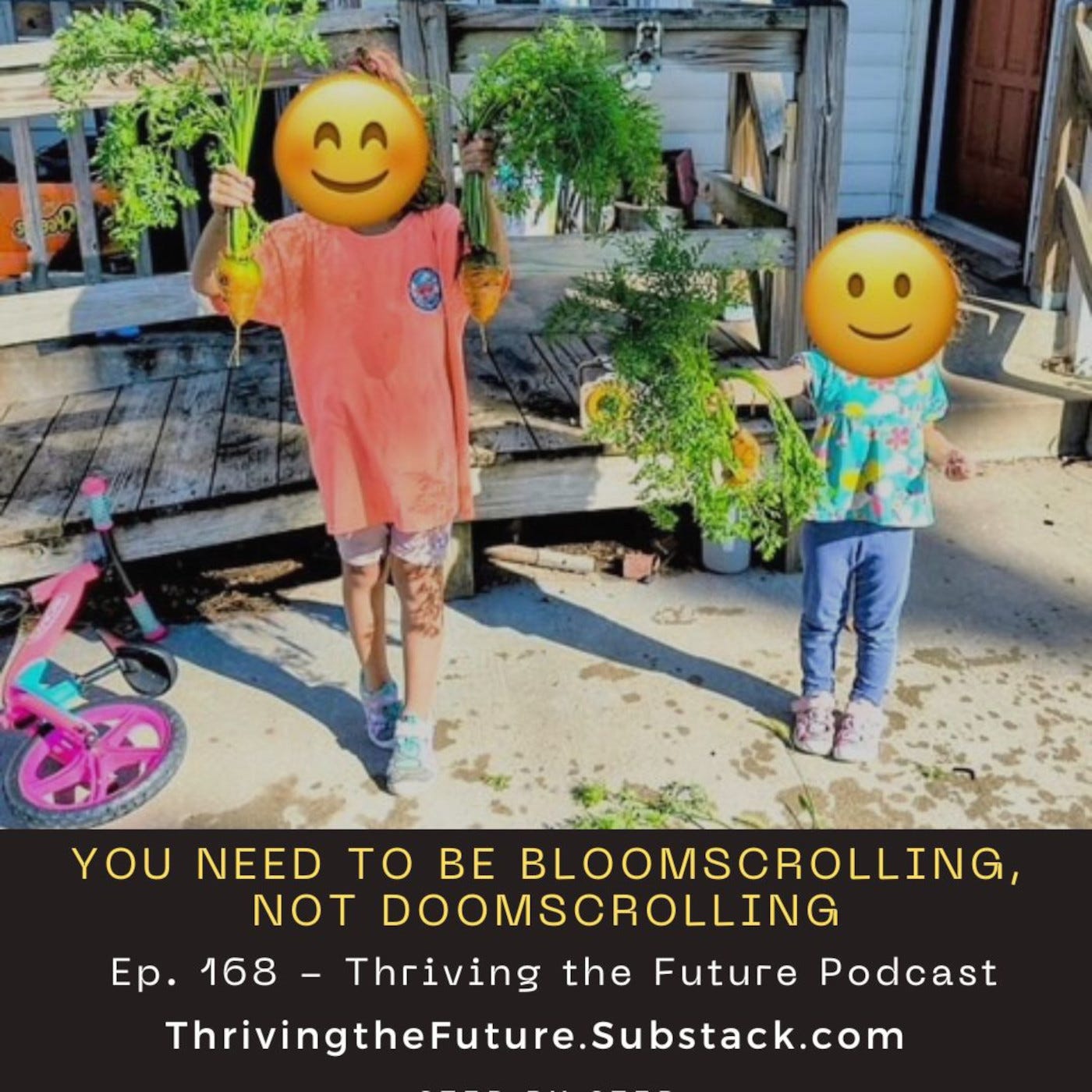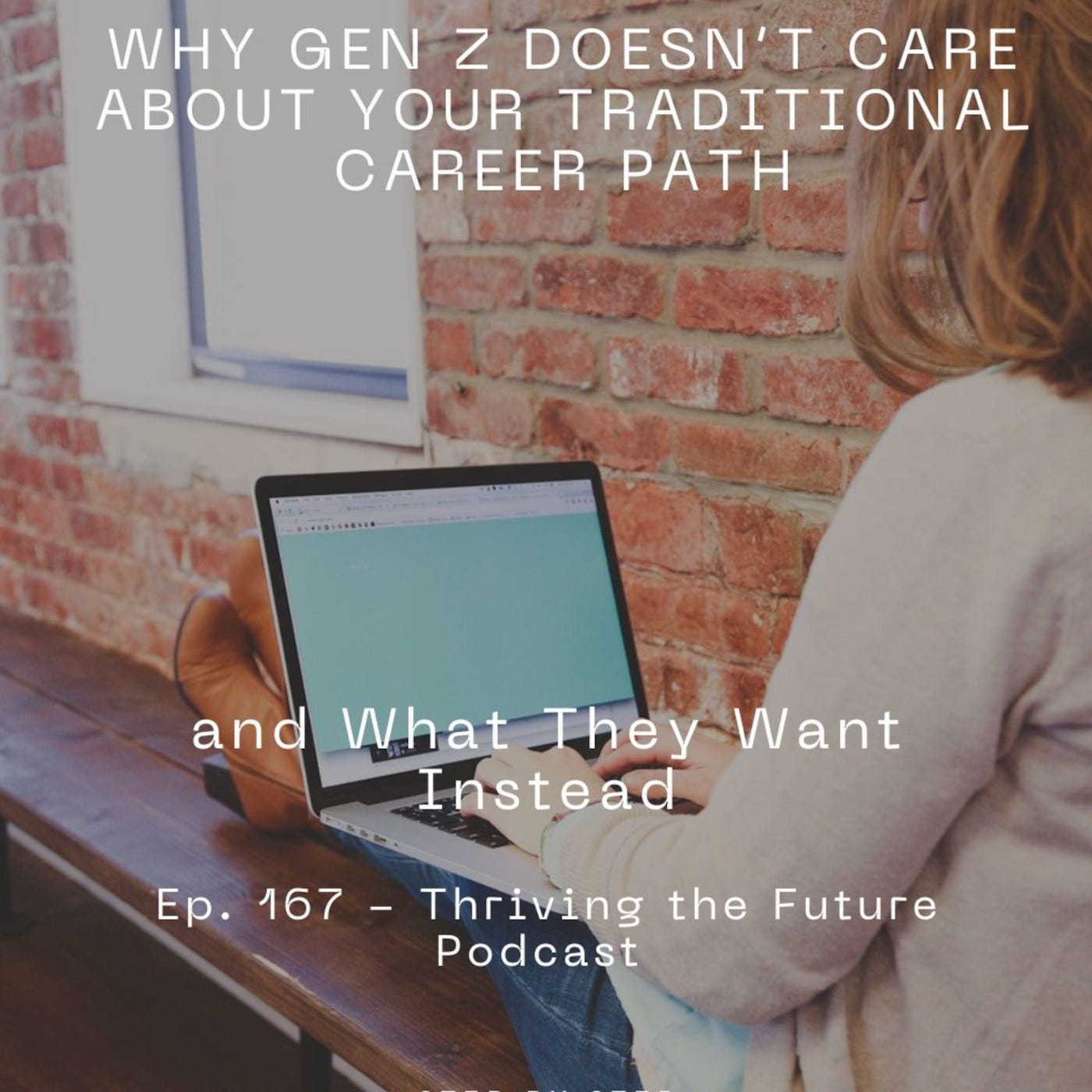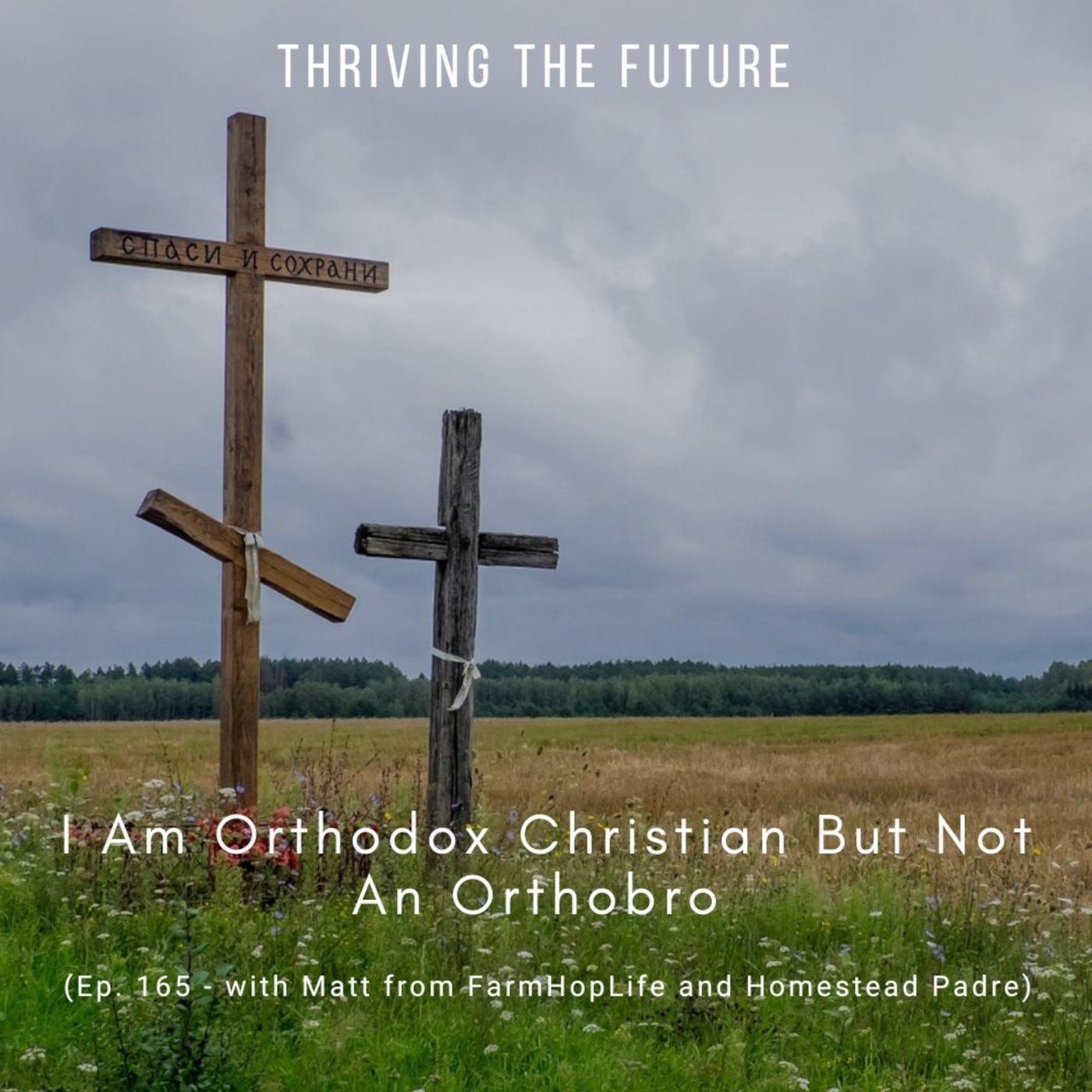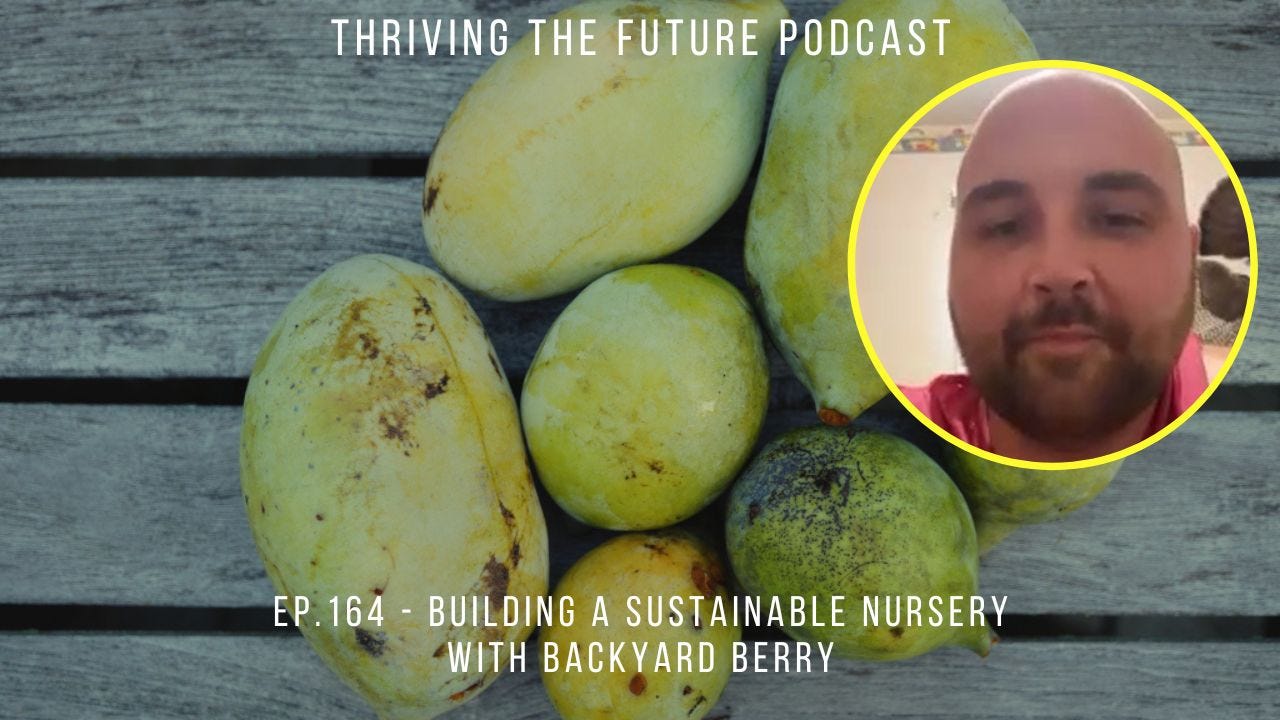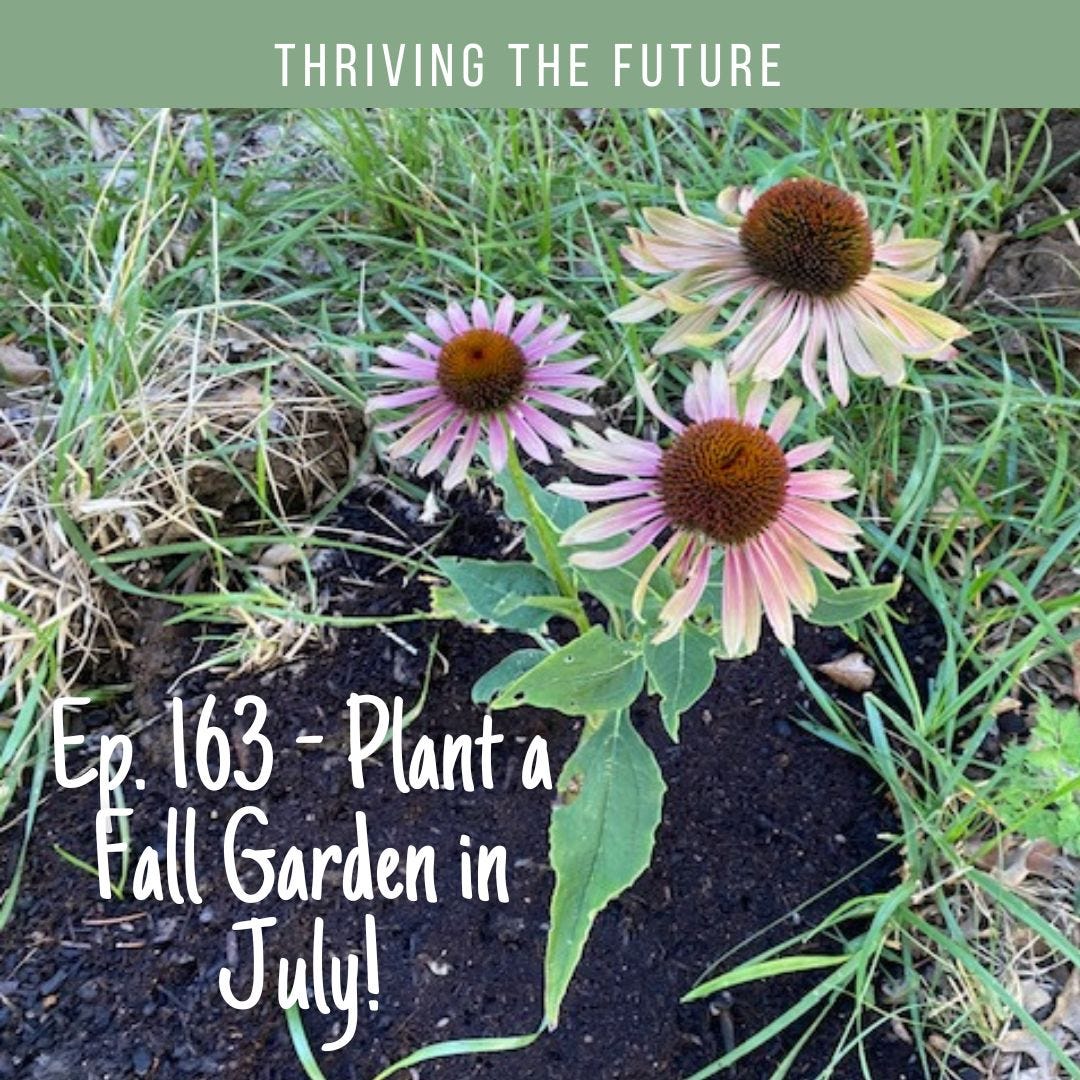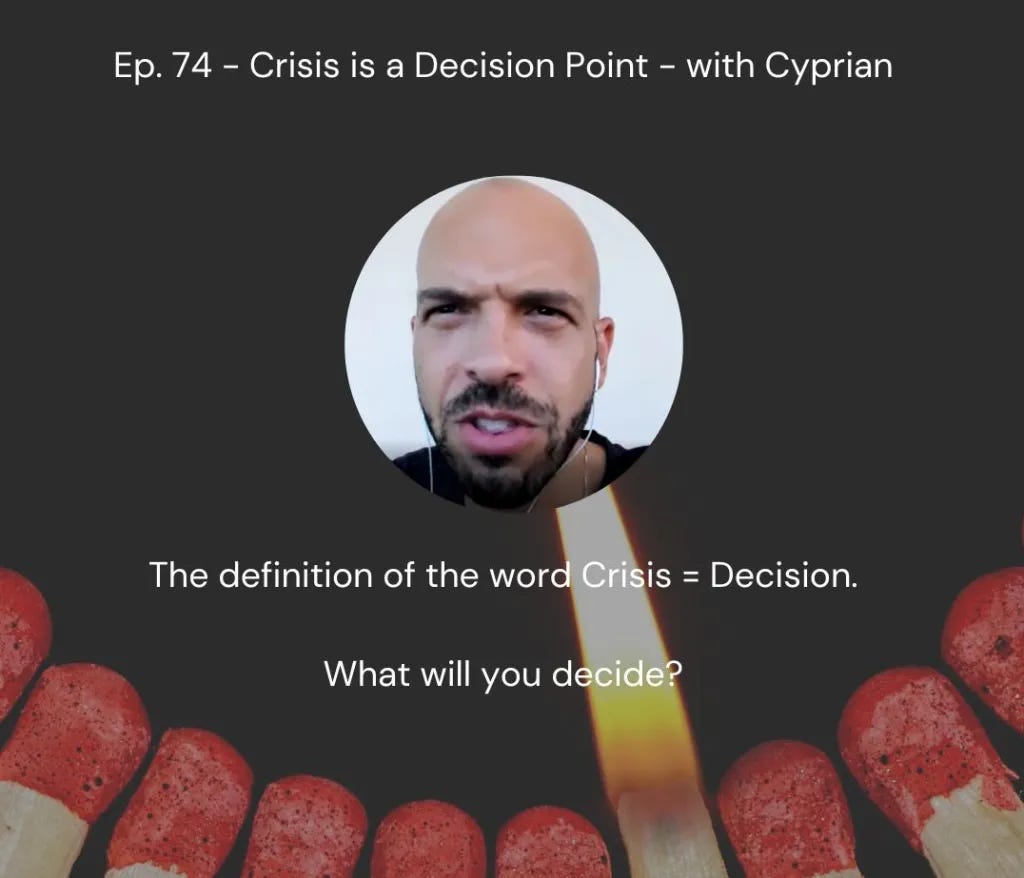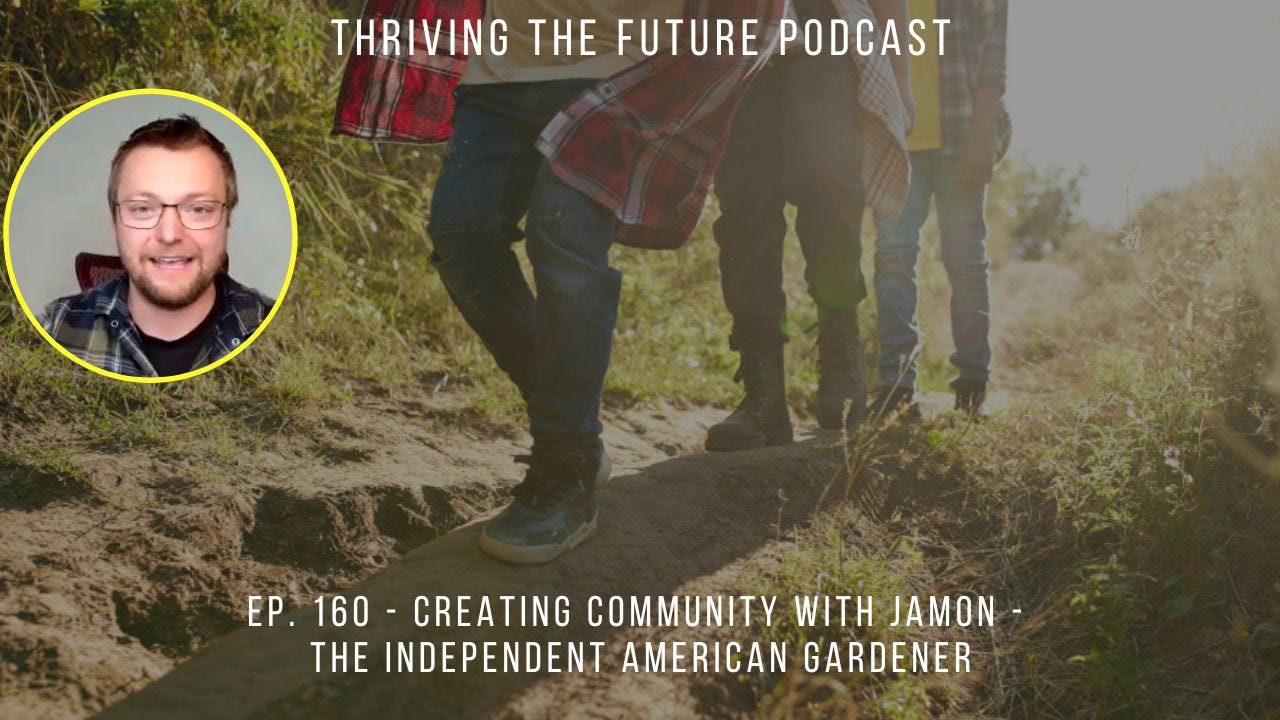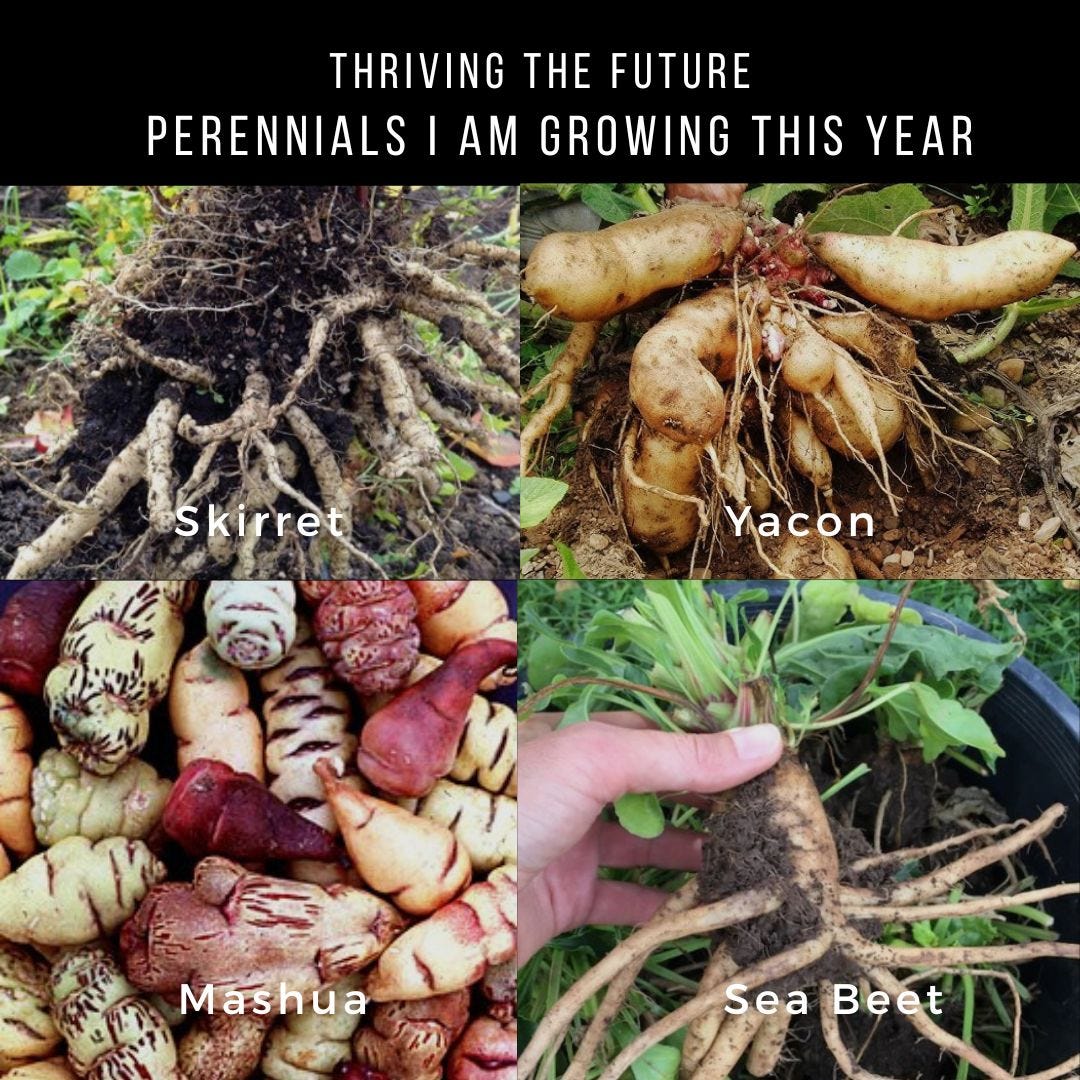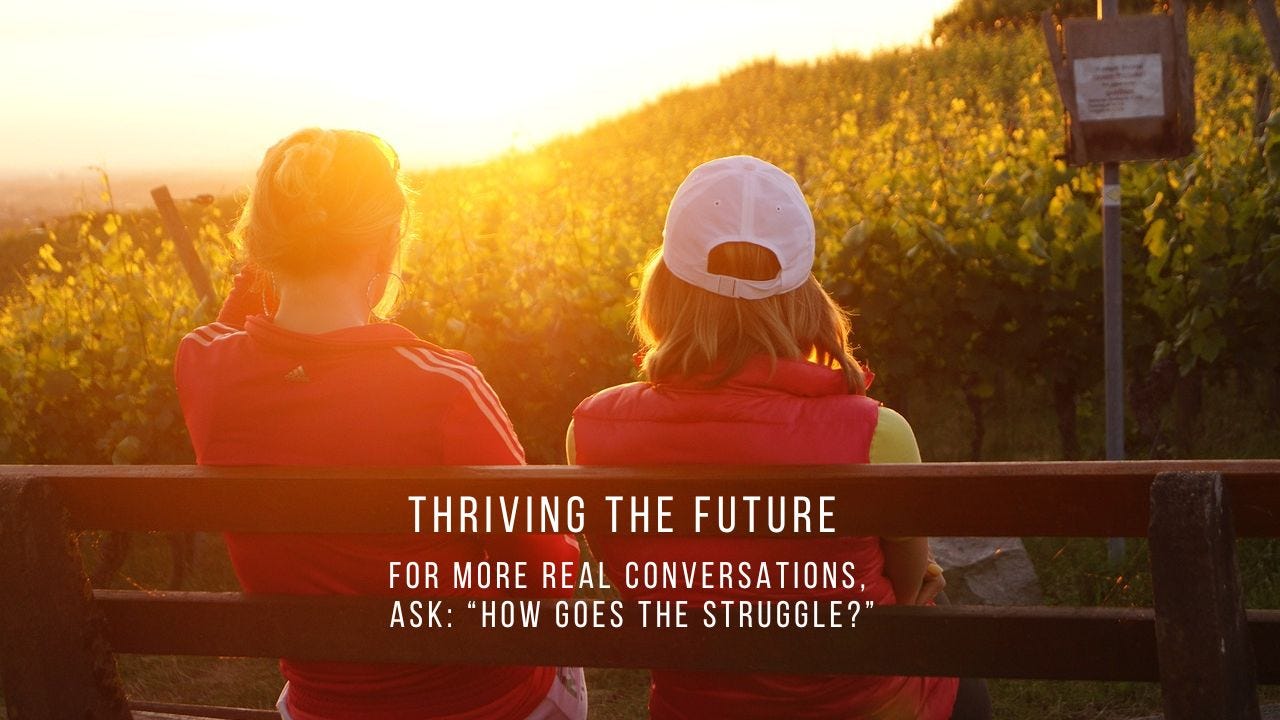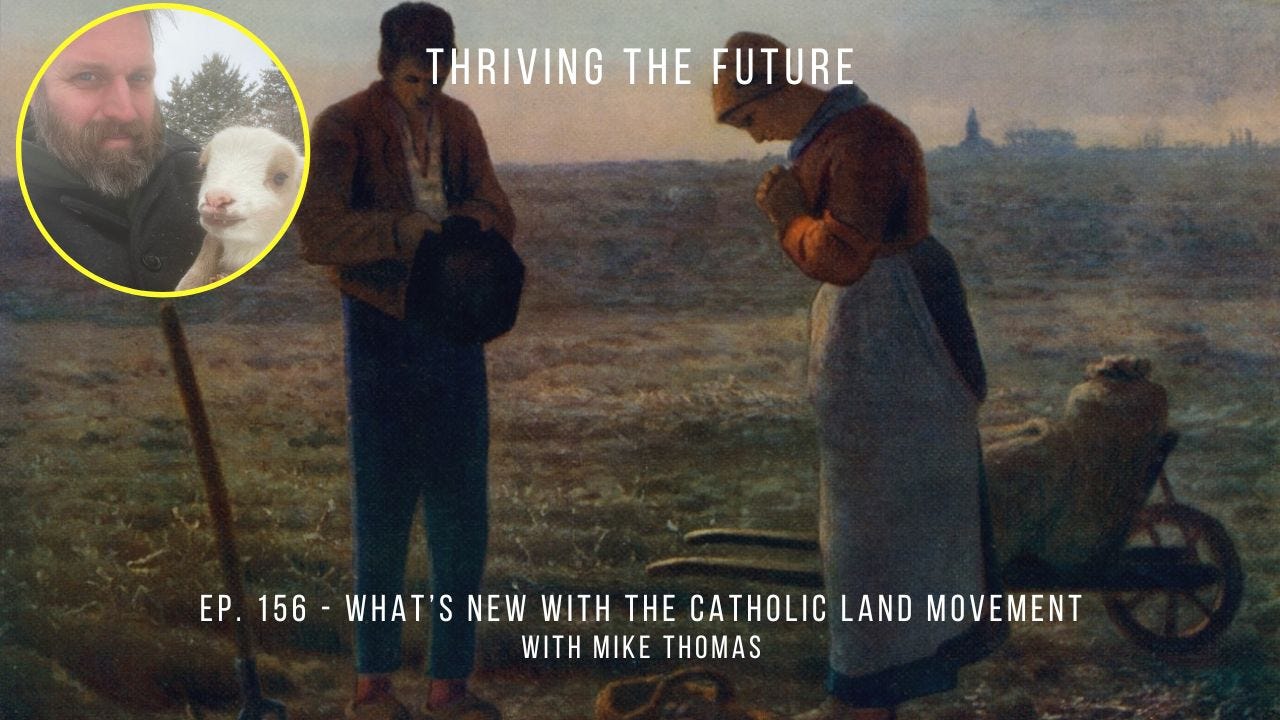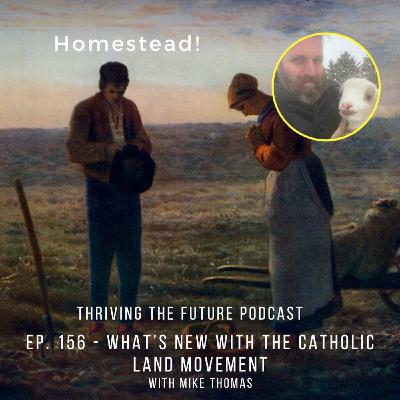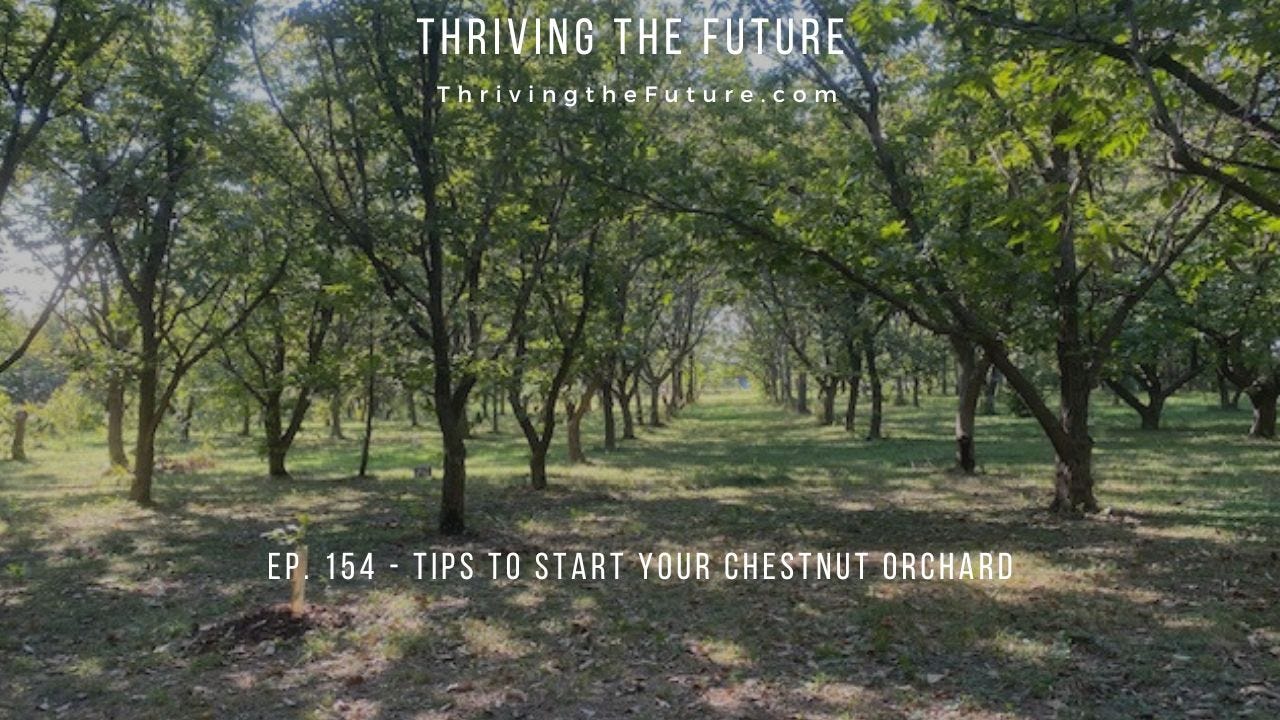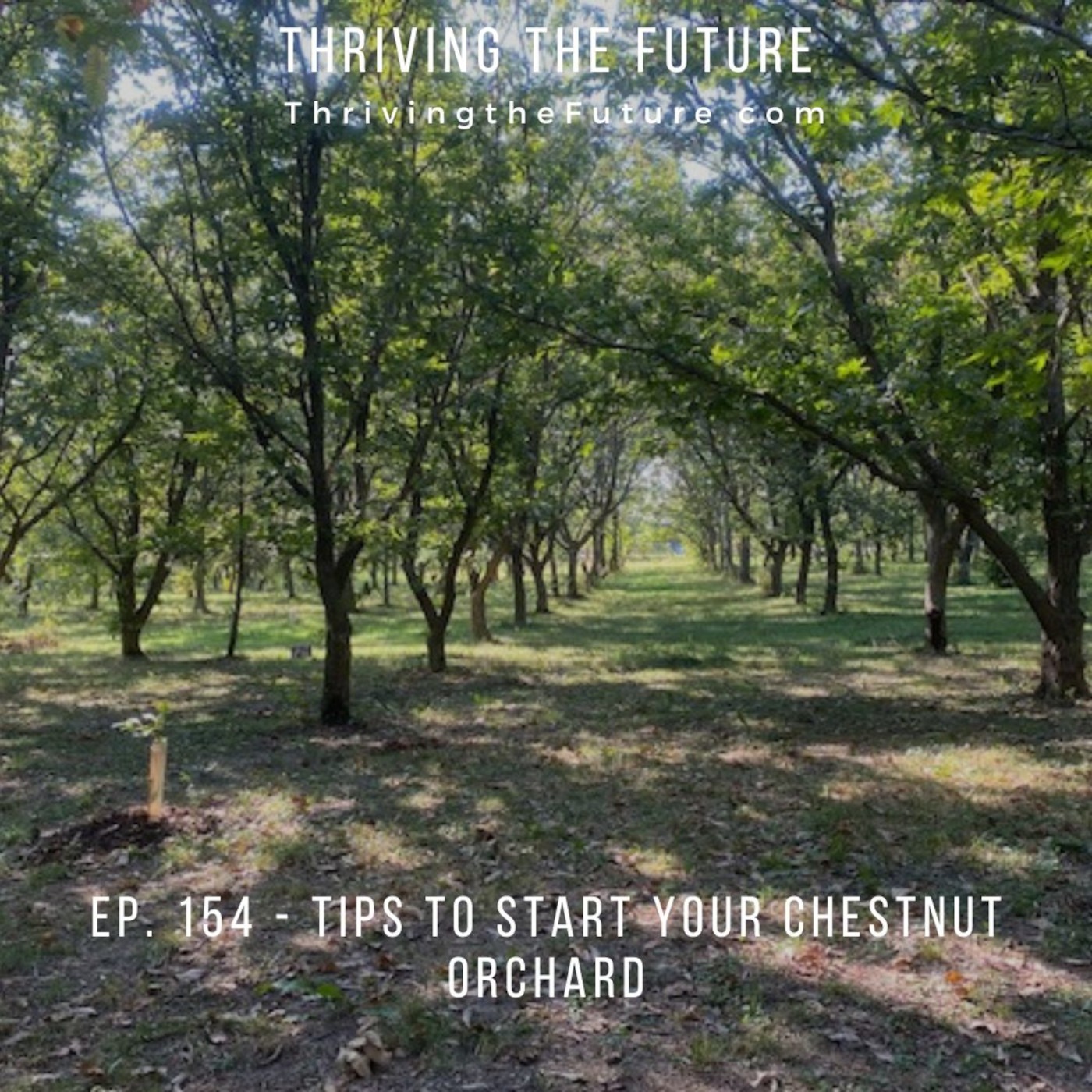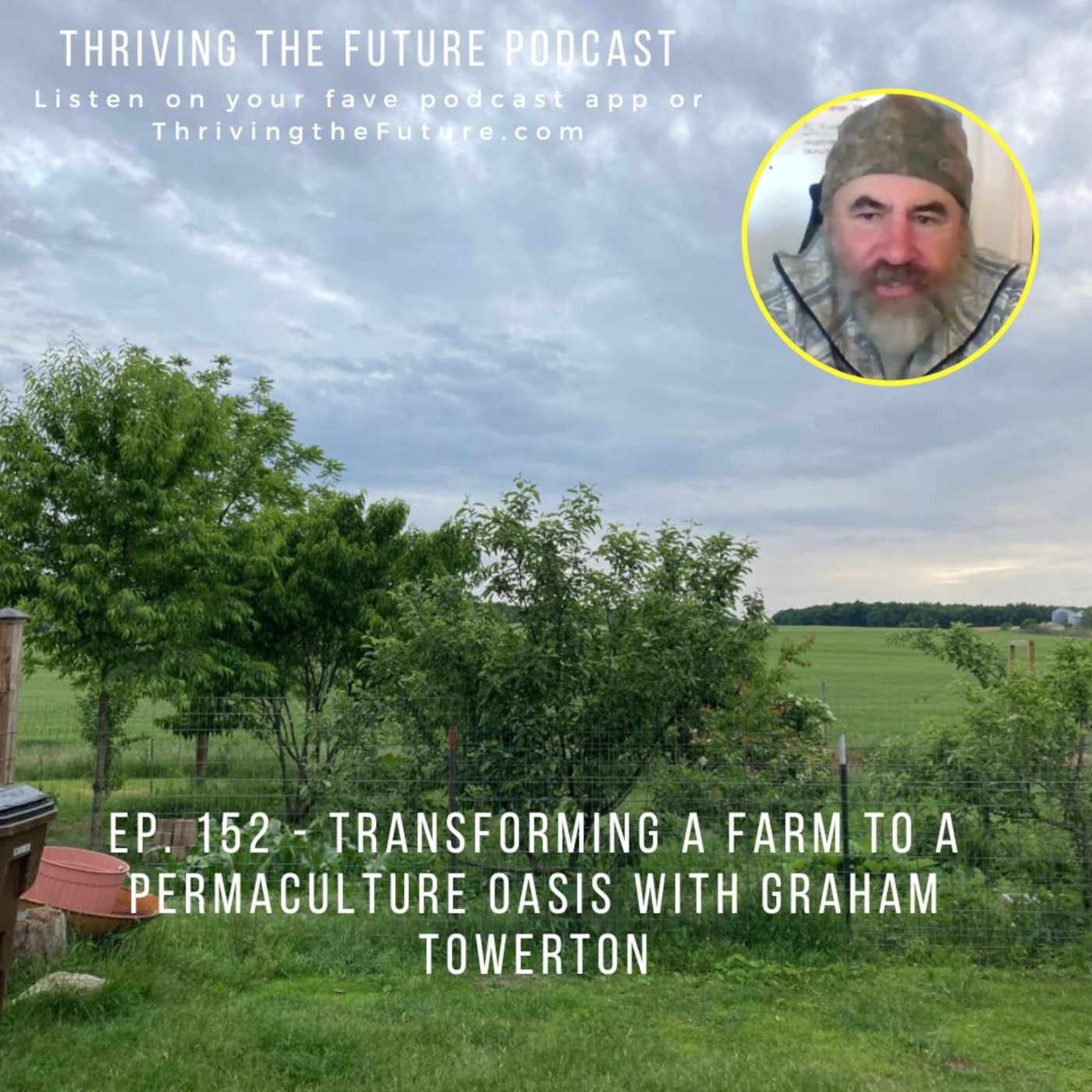Discover Thriving The Future Podcast
Thriving The Future Podcast

Thriving The Future Podcast
Author: Scott at Thriving the Future
Subscribed: 14Played: 334Subscribe
Share
© Thriving the Future
Description
Thriving The Future focuses on
👍- Positive solutions to help you #Thrive
🧭- Design your Intentional life.
🐓- Grow Food
🔨- Gain skills
🤝 – Build Community
Let’s Thrive together!
thrivingthefuture.substack.com
👍- Positive solutions to help you #Thrive
🧭- Design your Intentional life.
🐓- Grow Food
🔨- Gain skills
🤝 – Build Community
Let’s Thrive together!
thrivingthefuture.substack.com
154 Episodes
Reverse
We all need community. But divisions are destroying friendships and fracturing communities across America. Many people now refuse to associate with those who hold different views — avoiding them at farmer’s markets, skipping social gatherings, even ending decades-long friendships. But there’s another path forward: a framework to navigate forgiveness and create space for people in your outer circles without compromising your values.It is finally getting cool enough for fire pit and bonfire season.Last year, we skipped an invitation to a bonfire get-together because they were there. The couple that were champions of the Covid measures - the vaxx and the lockdowns. Does that mean we can’t even talk to those folks? We can’t even buy some of their salsa or kraut at the farmer’s market?Maybe it’s time to rethink community.We are a fractured society: How division destroys communityWe are a fractured society. People are splitting along ideological lines, and not associating with the folks in the other camps. While many of us are in the gray areas between those camps. It is fueled by their social media bubble. Just follow one person that leans to the other side (Red ort Blue) and it opens a whole different world of what they like and consume. To be fair, some die-hard Red folks I know post and repeat stuff that completely perplexes me (like Charlie Kirk conspiracies). It is like we are watching two different movies. Everyone is drawing lines. And it brings up comments: “I don’t want to buy something from them.” (at the farmer’s market)Like my kickoff story: “I don’t want to go to that bonfire get-together because they will be there.”Come on people. 🙄Maybe it’s time to rethink community.Covid is the Red Line for Many (still)For my wife, Covid was a Red Line, a betrayal, and those people can’t be trusted. This led to burned bridges and icy cold interactions, or more likely none at all.But now when you talk to people, you find out that yes, they took at least one round of the vaxx. This gets messy very quickly.We were at a dinner with several of our friends, including a couple that is our best friends. They were drinking, we were not. At one point, we were talking about conspiracies. My wife went to her favorite topic - Big Pharma. At that point my friend’s wife said, “We took the Covid shot. We wanted to travel.” My wife said, “Aha!”Her husband, my friend Dave, was talking to someone else and didn’t hear this conversation. I told him about it later and they both denied it. “Maybe your wife heard what she wanted to hear.” Well no, I heard it too. “Maybe she (my wife) was just drunk”, he said.My wife then talked about doubts of associating with them anymore. Maybe it’s time to rethink community.Thriving the Future Substack is a reader-supported publication. To receive new posts and support my work, consider becoming a free or paid subscriber.The Multiple Levels of CommunityRealistically, you have multiple levels of community already. They are concentric circles.You have your Inner Circle - Family and really close friends. Includes folks that you would call at 2 AM if your water heater breaks, or if you were in an accident and you needed a ride and you can’t get ahold of your immediate family.Then there are Friends and Allies. This includes your Mutual Assistance Group. Who you frequently communicate with, share, and trade with. You will help these folks out with clearing a tree that came down in their driveway last night during the storm. Some of those people extend into the Inner Circle. And you have Acquaintances. People in your outer circle. You may see them at church or a get-together. You don’t know them really well but you still talk to them. It may be someone you know by name at the farmer’s market.It’s funny, because I knew one prepper guy who inherently grouped people into these circles automatically as part of his OpSec. Needless to day, he has buckets of food, lots of guns, but very few friends. Times are getting tough. Maybe it’s time to rethink your community.The Other is the Invisible EnemyIn Ep. 121 - The Real Civil War is Within You, Cyprian talked about the Invisible Enemy. For the Left, it is White Supremacy. It’s the white guy with a rifle asking, “What kind of American are you?”For the Right, it’s Trans people or “illegals”.This past week, there were No Kings protests. Did they amount to much? No. But people are infuriated anyway. People are drawing lines in their personal relationships over ideology. In many cases, people are refusing to associate with those people, In history, this has always been the way you treat the Other. The outsider, the different color, the different religion, the different belief. For many, their ideology is now their Religion (with a capital “R”).We have people calling for the military on our streets - to clunk the heads of those people. Never mind that power can be used against you by the next people in power!I live next to the two blue-est counties in Kansas. I work in one of them.Let’s get real. If I was really choosy, I would have a difficult and lonely life.Maybe it’s time for forgiveness.Not talking about completely removing your standards.As I said, for some this is ideology. Can I still buy something at the farmer’s market from them?Maybe it’s time for forgiveness.“But they didn’t repent!”, some say.You are called to forgiveness. Even to forgive the Samaritan that you would cross on the other side of the street to avoid.Look, they don’t have to be in your Inner Circle! We used to have local workshops - No One is an Expert, But We are Still Gonna Get Stuff Done workshops. Processing chickens, making vinegar, showing newbies (and oldies) how to use crypto, bringing apples and pressing cider. Yes, there were some weirdos that attended. It’s OK. They can be in your community and not be in your Inner Circle.Times are getting tough. Maybe it’s time to rethink your community.Never before have we been more in need to be bloomscrolling, not doomscrolling.If you like this episode, then follow my Substack: ThrivingtheFutureIf you like this episode, Buy me a coffeeI still have chestnut seeds for sale at Grow Nut Trees. That’s at GrowNutTrees.com and BuyNutTrees.com. Get full access to Thriving the Future Substack at thrivingthefuture.substack.com/subscribe
You need to post your wins and surround yourself with positive people.Homeschool success story: We had the kids pick out their favorite plants from the seed catalog. We ordered the seeds. We cleared the unused raised beds in the backyard and they planted their seeds. They weeded it throughout the season. And now we have Oxheart carrots, watermelon, and Moonflower, which blooms at night.For the full show notes with pictures, go to the Thriving the Future SubstackWelcome back to Thriving the Future. If you spend any time on social media you feel almost certain that the world is coming to an end, Sauron discovered Frodo on the way to Mount Doom and now has the One Ring, and the orcs are at the gate. You are feeding your brain the mind rot with your doomscrolling.You need to be Bloomscrolling, not Doomscrolling.Post your wins, or if it didn’t work out, post your lessons learned. Chuckle and heartily laugh about it. It’s not so bad. There will be another season.You have seen the meme where there are two guys sitting on a bus. One looks out the window and complains. The other looks out the window and looks on the bright side. Surround yourself with people who are winning, posting positive stuff. Fall is my favorite time of the year, but the leaf changes creep later and later each year. I appreciate seeing the Fall foliage from up North (so keep posting it). Likewise, I love to see Andy Shagbark Hickman posting his Northern New York snow as deep as the door, and climbing up on the roof to shovel it off. Some people are horrified, because we have a culture that names Winter storms. I see everything right with the world. Celebrate your winsMy wins this week:I collected hundreds of chestnuts from two trees down the road from my house. Some will be eaten, others planted, some sold, and many shared.I had two giant sunflowers come up from the Milpa seed mix that I planted in the garden. I saved two quarts of seed from just one of those sunflowers.Had a huge harvest of autumn olive. This will make autumn olive oxymel for cold season.Back to my grandkids: as part of their homeschool project they collected caterpillars and watched them form cocoons, chrysalis, and hatch out as butterflies.My wife and I have been fire pit maxxing this year. We have a simple firepit made of cinder blocks. Three nights this week we have been sitting out at the firepit until we can barely stay awake, shooting stars from the October Draconis meteor shower overhead. I bought a grate for the firepit and we last week we cooked steaks in cast iron. Good community newsWe need to get back to sharing community news, sort of like the fictional Prairie Home Companion. (I bet that Andy would have some good stories from NNY).Surround yourself with people that are winningFollow people on social media that are winning, getting stuff done, sharing skills. Or even just sharing a picture of the sunset and the Fall foliage. Some of my favorites:Jason SnyderRoman from Nature School StartupJoseph the Homestead PadreLongstoryFarmsBrendan from Posterity Ciderworks. Listen to Ep. 113 – Finding Heirloom Apple Trees in Long Forgotten Homesteads episode where he tells of finding lost lost apple trees on abandoned homesteads.And, of course, Grant Payne from Christine Acre Farms, the most positive person on Twitter/X. Who gets more done by 24 years old than anyone I know. And is the luckiest guys I know. If you like this episode, then follow my Substack: ThrivingtheFutureBuy me a coffeeI still have chestnut seeds for sale at Grow Nut Trees. That’s at GrowNutTrees.com and BuyNutTrees.com. Get full access to Thriving the Future Substack at thrivingthefuture.substack.com/subscribe
My friend and coworker EngSean is Gen Z. He was born in 1997. Gen Z is usually considered to be born in or after 1997. (Although some sites say 1995, the general consensus is that Gen Z starts in 1997).EngSean graduated college two years ago. He got his professional certification about 6 months ago. But he was frustrated when discussing his next steps in his career path and the answer was basically: "You stay in this role for X number of years and then move to a Senior position or another position." That sounded like a slow treadmill or dead end to him.These kinds of conversations would get blank looks from the Gen X'ers he worked with (including me).These views and goals are not limited to EngSean. I spoke with my friend Grant Payne and he stated similar frustrations.EngSean and I usually walk 1.25 mile at lunch and his mindset was so different from mine that I thought it would be interesting to have him on the podcast.NOTE: The purpose of this is not to poke fun at Gen Z, but to understand them. This is important, whether you are a boss, coworker, or family member.Gen Z Mindset - Why Gen Z Quits JobsSo we tackled these questions:* What does a career look like to you?* What does Work/Life Balance look like?* You work with older professionals. What are some of things that you would like to be understood?* If you could accomplish one goal in the next year, what would it be?* We also discussed that, generally, they do not expect to ever receive Social Security or retirement.* It is important to them to have a job description with a listed salary range.* In social situations, they do not have small talk conversations about "What do you do?". Instead, sharing what $$ you make is important to them and does not have a stigma like it does for older professionals. This can make others upset!* They expect to change jobs every 2 years or so to get a better opportunity, more challenge, and especially to get better pay.Although EngSean doesn't feel this way, some Gen Z software developers think that they should be paid the same as senior people. Some think that "everyone should be paid the same" in that job role.Thriving the Future Substack is a reader-supported publication. To receive new posts and support my work, consider becoming a free or paid subscriber.Make sure to Subscribe to Thriving the Future Podcast!If you like this content, Buy Me a Coffee.Seeds and trees have a “memory”. They thrived and reproduced in a certain climate. Often when you buy chestnut trees or even hazelnut trees or plants online, you have to buy from nurseries in the Northeast or the Pacific Northwest. Take it from us: Trees and plants grown in those climates do not do well in Kansas or, in most cases, in the midsection of the country and Midwest.That's where Grow Nut Trees comes in. You buy nut trees from our Kansas homestead: chestnut, hazelnut, and I still have some pecans left, elderberry and comfrey. All grown and adapted to the Midwest, which will make them much more likely to be successful on your homestead or in your yard.And this year I have more named chestnuts sprouted from seed by me:* Dunstan-like American hybrids* Empire Elite, which is the chestnut that is used most often for turning corn and soy fields into chestnut farms* I have Revival which has a nut that's almost as big as my palm.* Chinese chestnuts.That’s at GrowNutTrees.com and BuyNutTrees.com. Get full access to Thriving the Future Substack at thrivingthefuture.substack.com/subscribe
There it is again. My heart races for just a few moments."What am I going to do about...?" the voice inside my head asks.Anxiety, you are a familiar "friend" in this New Normal, The Dim Age.But with "friends" like this, who needs enemies?Circle of ConcernI stop and ask myself:How much of this really matters? - That is my Circle of Concern.Does it really affect me?Let's get real. That thing that is happening in Texas or DC that is the Outrage-of-the-Day on social media. Does it really impact me?If I don't live in Texas, chances are it doesn't impact me at all.Does it even concern me?Probably not.How much of this can I actually do something about?Even if we are talking about in my home state or even in my city:Is it something I can directly do something about myself? - That is the Circle of Control.If the answer is "No", then Do I know someone involved? Are they a family member, friend, a co-worker, a neighbor? - That is the Circle of Influence.If I don't know the person and don't have any influence with them as a family member, friend, or acquaintance, the answer is almost surely "No".So why waste emotional energy on it?How many hours do I spend worrying about things I cannot control? Too many.I know that tomorrow I will have a challenging day, either dealing with conflict at work, at home, my water heater failed, or my car broke down.I like to role play out and strategize in my mind how I think that it will play out.What percentage of the time does it play out like I planned? Less than 10%.Tips to Focus on the Circle of Influence and Circle of ConcernI want to burn less emotional energy. I want to have less anxiety.I want to be free of the snares that so easily entangle me.Tip: Focus on the Circle of Influence and Circle of Concern.Only spend emotional energy on the things that fall inside these two circles; only on the things that really matter.Re-evaluate your relationships and spend more emotional energy and time on the people within those circles.Tips for dealing with adversityIn addition to focusing on your Circle of Influence and Circle of Concern, get back to what works:* Plant trees* Cultivate gardens* Raise livestock* Prepare mentally and spiritually* Grow your local communityBecause Government will not save you.If you like this content, Buy Me a Coffee.Your Mindset and Worldview MatterIt all goes back to your Worldview - Your Cosmology (How the world began) and your Eschaton (How will the world end).If you are a Nihilist then you ultimately see yourself as just a cosmic accident. There is no meaning. There are a lot of kids that are this way nowadays. It is inculcated throughout school. Add in climate anxiety, perceived sexual fluidity, and the overuse of prescription drugs and you can see why young people are messed up. Then you see why most of the recent school shootings are from very disturbed teens.Once again, don't fall into the trap. Those teens in another state are not in your Circle of Influence. But your kids and grandkids are in your Circle of Influence and Circle of Concern, and you can influence their mindset. Start by spending time with them. Share culture with them. Share your faith with them. Have real conversations. Show them that they matter.Perpend and I talked about Cosmology vs. Worldview back in Episode 85 in 2023. It was the last long conversation I had with Perpend before he went to become a monk (Brother David) at the monastery.How will your world end? What are you prepping for?In March 2020, when the Lockdown started, even the preppers were surprised. We had prepped for a run on the grocery store. I had enough stuff. So why was I standing in the checkout line with more? Because we didn't believe that it was happening. We didn't really believe that it could happen in America. Our mindset was all wrong.Hard times will come. Adversity is Normal. (there, I said it). Somehow we have isolated ourselves from it. We believe the American dream that we have a Right to Life, Liberty, and the Pursuit of Happiness. Most people believe that means that we are guaranteed Happiness.Our lives are fake. We are unhappy about foolish things - "I don't have this or that".We have forgotten that "Hard times create strong men."We want Good times, but that creates Weak men.In "God's Revelation to the Human Heart", Father Seraphim Rose said that he met a young man who wanted to go to Russia in the 1980's. Not to bask in Socialism, but because he heard that people were suffering for their faith. "Where there is suffering, he thought, there will probably be something real, and there will not be such fakery as we have in America."Father Seraphim said, "I saw that his idea was quite sound: the idea that suffering might produce something genuine, while our indulgent life easily produces fakery."Are you preparing your mind and your heart for Hard times?Seeds and trees have a “memory”. They thrived and reproduced in a certain climate. Often when you buy chestnut trees or even hazelnut trees or plants online, you have to buy from nurseries in the Northeast or the Pacific Northwest. Take it from us: Trees and plants grown in those climates do not do well in Kansas or, in most cases, in the midsection of the country and Midwest.That's where Grow Nut Trees comes in. You buy nut trees from our Kansas homestead: chestnut, hazelnut, and I still have some pecans left, elderberry and comfrey. All grown and adapted to the Midwest, which will make them much more likely to be successful on your homestead or in your yard.And this year I have more named chestnuts sprouted from seed by me:* Dunstan-like American hybrids* Empire Elite, which is the chestnut that is used most often for turning corn and soy fields into chestnut farms* I have Revival which has a nut that's almost as big as my palm.* Chinese chestnuts.That’s at GrowNutTrees.com and BuyNutTrees.com.GrowNutTrees.comRaised beds that I built to test Perennial Kitchen Garden layouts:Vego Garden Modular Metal Raised Bed (which I will make 5' x 3.5', 17" tall).I use this for a perennial kitchen garden - growing herbs to use daily in the kitchen. Just come along and pick what you need for tonight's dinner. Get full access to Thriving the Future Substack at thrivingthefuture.substack.com/subscribe
This week I have Matt from FarmHopLife and Joseph the Homestead Padre with me. And we're going to talk about Orthodoxy.So why this topic? Because it seems like online, all you see from Orthodox are all these new converts and they are all arguing with evangelicals and Catholics. And there are not like regular conversations going on like Perpend (now the monk Brother David) and I used to have. And this would be the kind of conversation that we would have if he were here. We are on an Orthodox journey. I've been Orthodox for a couple of years, and I'd like to hear some more about Matt and Joseph’s Orthodox journeys. So that's what we'll do, we'll do the anti-Orthobro thing and explore your Orthodox journeys.We focus on 3 main questions:* Why Orthodoxy?* What is the most surprising thing you have found on your Orthodox journey?* What is your biggest challenge?Listen in as we share our journeys and tell our stories. Seeds and trees have a “memory”. They thrived and reproduced in a certain climate. Often when you buy chestnut trees or even hazelnut trees or plants online, you have to buy from nurseries in the Northeast or the Pacific Northwest. Take it from us: Trees and plants grown in those climates do not do well in Kansas or, in most cases, in the midsection of the country and Midwest.That's where Grow Nut Trees comes in. You buy nut trees from our Kansas homestead: chestnut, hazelnut, and I still have some pecans left, elderberry and comfrey. All grown and adapted to the Midwest, which will make them much more likely to be successful on your homestead or in your yard.This year I have more named chestnuts sprouted from seed by me:* Dunstan-like American hybrids* Empire Elite, which is the chestnut that is used most often for turning corn and soy fields into chestnut farms* I have Revival which has a nut that's almost as big as my palm.* Chinese chestnuts.That’s at GrowNutTrees.com and BuyNutTrees.com.GrowNutTrees.comRaised beds that I built to test Perennial Kitchen Garden layouts:Vego Garden Modular Metal Raised Bed (which I will make 5' x 3.5', 17" tall).I use this for a perennial kitchen garden - growing herbs to use daily in the kitchen. Just come along and pick what you need for tonight's dinner. Get full access to Thriving the Future Substack at thrivingthefuture.substack.com/subscribe
Travis from Backyard Berry on Substack shares about his series "Building a Sustainable Nursery".His favorite trees: Pawpaws, Persimmons, and Pin Cherries (for the birds).What is it like to be so near the central area where Pawpaws are grown, attending the festival. He is even drinking pawpaw ginger ale!We also talk about his series on "Homegrown National Park". Everyone was talking about national parks being affected by Federal land sales a few weeks ago. Travis posted that "What if the largest national park in America wasn’t a remote wilderness, but your own backyard?"The idea: "transforming America’s private land into vibrant habitat corridors that restore biodiversity and ecological health."Travis also shares about what it is like to work on an organic vegetable farm.Times are tough. You want to be more self sufficient and grow more food, with enough to share with family and friends or even sell some of that surplus.You’ve heard of this “food forest” thing, but it’s so overwhelming to get started. I can help.My Thriving Food Forest Design can help you realize your dreams of an edible foodscape or perennial paradise that will come back every year so you can grow more food and be more self sufficient. Schedule your FREE Discovery call with me at:Buy my chestnuts, hazelnuts, elderberry, and comfrey that are adapted to the Midwest.GrowNutTrees.comRaised beds that I am building to test Perennial Kitchen Garden layouts:Vego Garden Modular Metal Raised Bed (which I will make 5' x 3.5', 17" tall).I use this for a perennial kitchen garden - growing herbs to use daily in the kitchen. Just come along and pick what you need for tonight's dinner. Get full access to Thriving the Future Substack at thrivingthefuture.substack.com/subscribe
What can you grow in July?The seed displays are gone from the store. You can outdo the normies by planting a great Fall garden - even in the heat of July.I'm back! Where have I been all this time? I've planted a lot of things this Spring and for a while there I was watering day and night and working in the garden and turning over soil and one of the things that really was a problem was my garden got out of hand. It got really weedy because I don't go back there all that much. It's in Zone 2, borderline zone 3. My garden in Zone 2 is being taken over by bindweed, a really big hassle that is going to require some significant work during the down seasonI started building garden beds and raised beds closer to the house. That way I have more eyeballs on them and I can intervene without it being taken over by weeds.In addition to that, I've been spending a lot of time on having local conversations or just personal off-the-record conversations. There's no need to turn on the microphone and record everything all the time! Live in the moment!I've had great conversations with friends, folks that have been on the podcast before, and I have also been developing local community.Everything needs to go hyper-local and I'll talk more about that on a future episode.It's July in Kansas, and next week we are going to break 100 for the first time this Summer. We have had a lot of rain.None of the stores have any plants left. Around here, all the seed displays disappear around 4th of July and everything goes on clearance. This year I got a ton of stuff. I followed Grant Payne’s model and I went around and just cleaned out the clearance items. I got fig trees at Lowe’s, blackberries from Ace Hardware, and lots and lots of echinacea. I've got all kinds of different colors of echinacea that I planted pretty much everywhere.The normies aren't growing anything in July. Every time I have tried to grow or start something in July from seed, it usually fails just because of the heat. But as I'm looking at Clyde's Garden Planner, I put it at my last frost date, which is October 20th, and I've got a lot of options for things that can still be planted and can still be harvested by the time the frost comes, which is almost three months away. I can plant cabbage. Of course, cabbage can go past the first frost. I can plant cucumbers, okra. Pumpkins (if they're not 120-day pumpkins). You can plant winter squash, carrots, of course, and a lot of greens. Now the carrots and the greens will not germinate because of the sun and the heat and the soil temperature, but I have a couple of garden beds that are in the partial shade and I've been able to plant Black Seeded Simpson lettuce, which is my favorite kind of lettuce. It is the cut-and-come-again lettuce. I've been able to plant it in the raised beds and get it to germinate.You could use shade cloth to shelter it enough to maybe get it to germinate in the full garden.Another benefit is if you plant squash this late, then you can sometimes avoid the squash bugs because the squash bug wave has passed by the time the squash is getting ready to bear. That's happened to me a couple of times. I have been able to get Winter Squash. It gets kind of squirrely because it gets a bit close to that first Frost date. But last year we had this kind of weather pattern where we had rain into July. And then it turned hot and dry with drought, and it stayed hot all the way through the Fall. We didn't have a normal Fall at all, and the first major frost was not until Thanksgiving (instead of October 20th). It made for some miserable deer hunting. It made it difficult to dig up some trees and replant them somewhere else, because they weren't fully dormant yet. But one of the side benefits was that if I planted trees in September that gave me a little bit more time for root growth. I planted 2 apple trees in September and they had great root growth, and came back super strong this Spring.I also have sweet potatoes that are growing really well. In previous years I have had sweet potatoes that were as big as footballs.So give it a try. Don't give up on your garden and you'll have a great harvest this Fall.Times are tough. You want to be more self sufficient and grow more food, with enough to share with family and friends or even sell some of that surplus.You’ve heard of this “food forest” thing, but it’s so overwhelming to get started. I can help.My Thriving Food Forest Design can help you realize your dreams of an edible foodscape or perennial paradise that will come back every year so you can grow more food and be more self sufficient. Schedule your FREE Discovery call with me at:Buy my chestnuts, hazelnuts, elderberry, and comfrey that are adapted to the Midwest.GrowNutTrees.comRaised beds that I am building to test Perennial Kitchen Garden layouts:Vego Garden Modular Metal Raised Bed (which I will make 5' x 3.5', 17" tall).I use this for a perennial kitchen garden - growing herbs to use daily in the kitchen. Just come along and pick what you need for tonight's dinner. Get full access to Thriving the Future Substack at thrivingthefuture.substack.com/subscribe
We are facing a crisis. One right after another.This is an episode from April 2023 with Cyprian (formerly Vin Armani). It includes the never-before-published bonus content where Cyprian talks about Bitcoin maximism, and the Cargo Cult.Cyprian tweeted in 2023: “‘Crisis’ means ‘decision’. Just knowing that fact changes your understanding of reality forever.”Crisis is a decision point. And “never let a good crisis go to waste.” – Rahm Emmanuel.* Are you prepared – mentally and spiritually – for what is coming?* As Cyprian said in March 2020, “the world as you know it has ended. You need to get to acceptance.”* The larger game at play – It’s all spiritual warfare. Ephesians 6:12.* #BuildTheArk – what does that mean?* OrthodoxySpiritual Warfare – Ephesians 6:12With all this happening you need to get more self sufficient. Grow you own food. WE can help.Grow Nut Trees is now taking chestnuts, hazelnuts, elderberry, and comfrey orders for Fall. The trees are adapted to the Midwest. Check it out at:GrowNutTrees.comThriving Food Forest Design: If you like this, let us create an edible foodscape, perennial paradise for you so you can grow more food and be more self sufficient. Schedule a free consult session with me at: Get full access to Thriving the Future Substack at thrivingthefuture.substack.com/subscribe
Jamon Mysliwiec (@theindependentamericangardener) joins me to share about TIAG - The Independent American Gardener, an online to in-real-life community, teaching permaculture and self-sufficiency through regenerative community.The goal is to move to a closed-loop economy, with communities producing surplus, leveraging home based small businesses, and creating a barter and trade network for the surplus.Jamon started Lulu's Garden, the first Demonstration Hub in Trenton, MO, and has bought a commercial property which will have a rooftop garden, greenhouse, a food forest, and to trade surplus through a farmers market type model.He also shares about his new off grid property and soon-to-be-Demonstration Hub in SW Missouri.Thriving Food Forest Design: Let us create an edible foodscape, perennial paradise for you so you can grow more food and be more self sufficient. Schedule a free consult session with me at:Buy my chestnuts, hazelnuts, elderberry, and comfrey that are adapted to the Midwest.GrowNutTrees.comRaised beds that I am building to test Perennial Kitchen Garden layouts:Vego Garden Modular Metal Raised Bed (which I will make 5' x 3.5', 17" tall).I use this for a perennial kitchen garden - growing herbs to use daily in the kitchen. Just come along and pick what you need for tonight's dinner.Meadow Creature Broadfork is my favorite tool for starting new garden beds. I turn over the sod, add a layer of compost, then Milpa, and cover with woodchips. Get full access to Thriving the Future Substack at thrivingthefuture.substack.com/subscribe
As I get older, perennials have become more important in my garden.It is the first week of May, and this Spring I have not planted any new annuals, besides potatoes. But that doesn't mean that I do not have anything to eat. A couple of years ago I focused more and more corners of my garden and raised beds on perennials. I have bloody dock and other sorrel to add to salads. Bloody dock has a lemony taste, and it's blood red veins add an intriguing conversation piece when added to a guest's salad.The Milpa bed has 2nd year cabbage, arugula, and mustard greens that can be foraged and added to salads and smoothies. The arugula and mustard greens need to gathered early before they go to seed.Narrow leaf plantain is also added to smoothies.I have oregano in a raised bed kitchen garden that is far better than any store bought oregano (and I will never go back!).I have walking onions that are so numerous that I have many to thin and add to other beds and into the food forest. As well as gift to friends, for I have more onions than I can eat.Jerusalem artichoke (sunchoke) tubers are mostly sprouting new plants, but some can still be harvested. I planted a variety a few years ago that is white, more circular and less lobulated than most sunchokes.I have added raised bed kitchen gardens in Zone 1 near the house, using two Vego Garden Modular Metal Raised Beds, and I want to increase my perennial options.SkirretThis year I will add Skirret, which is a perennial that looks like a carrot and is described as "the sweetest carrot you've ever eaten." Skirret is a European perennial, popular in medieval times. Instead of one tap root, the skirret has multiple tubers off of a plant. I got the seed from Perma Gardens at plantonce.comYaconYacon is a plant that has a deep tubers that look like a small sweet potato, and smaller tubers near the surface that look like sunchokes. Above ground it will look like a sunflower. It reportedly has a juicy fruity flavor like celery or fruit. I bought my Yacon at Raintree Nursery, and they also have a purple variety.MashuaMashua is a plant in the Nasturtium family. It is a vining and flowering plant, but also forms tubers. The leaves and flower are edible. And it repels some insects and nematodes, so you can plant it between other plants. The tubers can also come in different colors. I bought my Mashua at Raintree Nursery.Sea BeetSea beet is an ancestor of our beets and chard. It will have large edible leaves. It seeds in Year 2 and then, in midsection of country it would likely go perennial in Year 3.It is not a red beet, and I expect it to be more like a chard taste or closer to a sugar beet. I bought mine at Experimental Farm Network, which has unique things you may not find in your regular store or the usual online seed places.Perennial KaleI frequently can get kale to come back in the next year, especially if it is a thicker leafed kale like Scotch Kale. You can also get some ornamental kale that comes back every year. Those may not be great in salad, but you could eat the tender new "baby kale" or blend it into smoothies. Experimental Farm Network has been experimenting with choosing kale varieties that would be more likely to go perennial. They call it the 'Homesteader's Kaleidoscopic Perennial' Kale Grex. "Grex" is a horticulture term meaning a hybrid. I have tried this (and will continue to try it) to discover the elusive perennial kale.ChicoryAnd I go back to my tried and true chicory, which also comes back. I plant this along borders in the garden and in ground beds. I also have it growing wild up and down the driveway. You can roast chicory root as a coffee substitute (although I don't care for it). My chickens love the greens and I add it to smoothies.Try some of these plants, especially the tubers, and increase your self sufficiency by experimenting to see if you can get some of them to turn perennial.Buy my chestnuts, hazelnuts, elderberry, and comfrey that are adapted to the Midwest.Use “thriving” at checkout for 10% (through May-10).GrowNutTrees.com Get full access to Thriving the Future Substack at thrivingthefuture.substack.com/subscribe
Matt from FarmHopLife, Joseph the Homestead Padre from Smith Homestead, and Grant Payne from Christine Acres Farm join me on a community call to share our Spring plans.Matt is growing mini cactusHomestead Padre is growing Ayote squash which tastes like chocolate. He also shares his farmers market success with selling freeze dried herbs, teas, and candy.I am growing new types of chestnuts, and grafting Asian pears onto invasive Callery pears.And Grant is doing everything. Greenhouses, IBC totes with comfrey as far as the eye can see, ducks, chickens, trees, and hundred of flowers.Come and join in our success!Thriving Food Forest Design: Let us create an edible foodscape, perennial paradise for you so you can grow more food and be more self sufficient. Schedule a free consult session with me at:Buy my chestnuts, hazelnuts, elderberry, and comfrey that are adapted to the Midwest.GrowNutTrees.comRaised beds that I am building to test Perennial Kitchen Garden layouts:Vego Garden Modular Metal Raised Bed (which I will make 5' x 3.5', 17" tall).I use this for a perennial kitchen garden - growing herbs to use daily in the kitchen. Just come along and pick what you need for tonight's dinner.Meadow Creature Broadfork is my favorite tool for starting new garden beds. I turn over the sod, add a layer of compost, then Milpa, and cover with woodchips. Get full access to Thriving the Future Substack at thrivingthefuture.substack.com/subscribe
Perpend (David), who I started the podcast with, became an Orthodox monk and is now a Novice Monk at the Monastery of St. John in CA.As he was travelling from monastery to monastery throughout America, he occasionally was back in Kansas (the last time in September 2023). He would greet me, and others, with a greeting that he likely learned in his travels: Instead of saying, "Hi, how are you?", he would say, "How goes the struggle?"Instead of giving the usual response of "I am fine", you would think about it for a moment. This led to a more real and heartfelt conversation.The Struggle is RealIn Orthodox Christianity there is a prayer: "Help the Orthodox Christians to struggle".Not "Help us get through the struggle". Not "Help us not to struggle".If you are saying to yourself, "That's un-American!", then you have lost touch with your history and tradition.I could go on for paragraphs here about how we have lost this touchstone of our human existence.We knew this just 100 years ago. The janitor knew that he was janitor and measured where he was in the world. He would hope and prepare his children to have a life better than his, but he knew where he was. In modern days, through credit the janitor thinks he can drive that fancy car.I know. I was a janitor's (well, "groundkeeper's") kid.I visited the Kansas State Capitol building at lunch the other day. The motifs and murals are all about Manifest Destiny. They proclaim that we will somehow expand and conquer the land.Even the Wokes inherently know that when they call for struggle. "The struggle is real." But they are struggling for Utopia that will never come.Likewise, too many people today are looking for Utopia.The Hero's JourneyWe watch TV or a movie and cheer when the hero goes through trials and comes out the victor at the end. We respond to these because these Hero's Journey stories are in our DNA.But now we watch the Hero's Journey story and do not want to experience trials and struggles ourselves.People watch TV and movies with the Hero’s Journey and then grumble, complain, and take meds when they are called to the Hero’s Journey.We need to struggle. We need the Hero's Journey.In the Midst of Great LentI am writing this in Week 4 of Great Lent. Just passed the midpoint between the start of Lent and Pascha/Easter, which this year is on April 20.Lent for the Orthodox is 40 days of fasting, plus Holy Week. The fast is much more than other Christian traditions: Abstain from meat, fish, dairy, eggs, and (most of the time) wine and rich oils like olive oil. That's every day, not just fasting on Friday. (Sorry, no Friday Fish Frys).The purpose of Lent is to examine yourself, through prayer and counsel - in ways that are not possible if you are well fed.Proverbs 30: 8-9:Give me neither poverty nor riches—Feed me with the food allotted to me;Lest I be full and deny You, And say, “Who is the Lord?”Or lest I be poor and steal,And profane the name of my God.The Lord's Prayer says: "Give us our daily bread". Not "bless us at the all-you-can-eat buffet".Embrace the Weeks of WantThere is a seasonality to it as well. These were known as the "Weeks of Want" - the historical time at the end of Winter, where your stored food ran low, you could only do minimal foraging in the woods, and the new crops have not come in yet.Maybe we will get back to living locally. Localism, or as Andy Hickman says, "Yokelism".What Does This Have to Do With Thriving?You may be saying to yourself: "This doesn't sound like Thriving."I disagree. Thriving is designing your intentional life. That includes celebrating the good times, but also preparing for upset, for down times, and to help others as they go through their own struggles and tough times.That is the Human Equation.WAY back in Episode 13 – So You Want a Parallel Economy? – Solzhenitsyn and Havel, we talked about Vaclav Havel's solution to totalitarianism. In the waning days of the Soviet Communist empire, Vaclav encouraged citizens in Czechoslovakia to get together for community - picnics, art. Rediscover community. This overcomes isolationism, which is something that we struggle with: We are more connected (electronically) that ever yet are completely alone.Want to have an interesting conversation?Ask: "How goes the Struggle?" Try this greeting out with your friends and at church gatherings. It will cut through the cheery veneer and lead to some interesting conversations... or it will make people really upset.At least you will be having crucial conversations instead of mundane empty ones.Thriving Food Forest Design: Let us create an edible foodscape, perennial paradise for you so you can grow more food and be more self sufficient. Schedule a free consult session with me at:Buy my chestnuts, hazelnuts, elderberry, and comfrey that are adapted to the Midwest.GrowNutTrees.comRaised beds that I am building to test Perennial Kitchen Garden layouts:Vego Garden Modular Metal Raised Bed (which I will make 5' x 3.5', 17" tall).I use this for a perennial kitchen garden - growing herbs to use daily in the kitchen. Just come along and pick what you need for tonight's dinner.Meadow Creature Broadfork is my favorite tool for starting new garden beds. I turn over the sod, add a layer of compost, then Milpa, and cover with woodchips. Get full access to Thriving the Future Substack at thrivingthefuture.substack.com/subscribe
Mike Thomas of the Catholic Land Movement joins me to talk about Catholic Land Movement news. We also share about our apple orchards and cider.The purpose of the Catholic Land Movement is "a rural resettlement of Catholics onto productive property which they own".This is a network of Catholics supporting one another to help people start homesteads, and to help make homesteads and small farms thrive. They do this through helping folks find land, as well as skill swapping and workshops.* The Catholic Land Movement is now up to 30+ chapters!* Mike and his team visited Rome to discuss their mission and were able to meet with Pope Francis.* Now it is a 501c3 and you can donate to help the Catholic Land Movement.* We also share about apple trees, progress in our orchards, my challenges with fire blight, and lambing season on the homestead.* It has been so cold that his cider froze. How Mike will recover and try to to restart the fermentation.* We talk about the joy of watching new lambs.We also talk about Lent and Mike's recent tweet: "Time to use Lent to purify myself, to conquer my disorder and weakness. Time to build a foundation."Thriving Food Forest Design: Let us create an edible foodscape, perennial paradise for you so you can grow more food and be more self sufficient. Schedule a free consult session with me at:Buy my chestnuts, hazelnuts, elderberry, and comfrey that are adapted to the Midwest.GrowNutTrees.comRaised beds that I am building to test Perennial Kitchen Garden layouts:Vego Garden Modular Metal Raised Bed (which I will make 5′ x 3.5′, 17″ tall).I use this for a perennial kitchen garden – growing herbs to use daily in the kitchen. Just come along and pick what you need for tonight’s dinner.Meadow Creature Broadfork is my favorite tool for starting new garden beds. I turn over the sod, add a layer of compost, then Milpa, and cover with woodchips. Get full access to Thriving the Future Substack at thrivingthefuture.substack.com/subscribe
Mike Thomas of the Catholic Land Movement joins me to talk about Catholic Land Movement news. We also share about our apple orchards and cider.The purpose of the Catholic Land Movement is "a rural resettlement of Catholics onto productive property which they own".This is a network of Catholics supporting one another to help people start homesteads, and to help make homesteads and small farms thrive. They do this through helping folks find land, as well as skill swapping and workshops.The Catholic Land Movement is now up to 30+ chapters.Mike and his team visited Rome to discuss their mission and were able to meet with Pope Francis.Now is a 501c3 and you can donate to help the Catholic Land Movement.We also share about apple trees, progress in our orchards, my challenges with fire blight, and lambing season on the homestead.It has been so cold that his cider froze. How Mike will recover and try to to restart the fermentation.We also talk about Lent and Mike's recent tweet: "Time to use Lent to purify myself, to conquer my disorder and weakness. Time to build a foundation."Show notes for this episode: Ep. 156 - How the Catholic Land Movement is Empowering HomesteadingGrow Nut Trees is now taking orders for Spring shipping or local pickup.Grow Nut Trees.comNEW for this year are more types of chestnuts, including Qing Chinese hybrid chestnut seedlings. The Qing tree is a heavy producer with sweet flavored extra large nuts. These seedlings were grown locally and are adapted to the Midwest.Thriving Food Forest Design:We can create an edible foodscape, an orchard, or perennial kitchen garden so you can grow more food and be more self sufficient. We use fruit and nut trees and perennial plants adapted to the Midwest to create a low maintenance food forest.Start your journey to Thriving with a free 30 min consult, a discovery call to learn your vision and goals for your land. Get full access to Thriving the Future Substack at thrivingthefuture.substack.com/subscribe
Roman Shapla, from Nature School Startup, joins me to discuss Nature Schools - where the outdoors is the classroom.Roman recently shared on Twitter how he has taught tracking class: showing kids animal tracks in the dirt teaches kids about pattern recognition, thinking through timelines, as well as problem solving in their surroundings ("if this track is here, where did it come from, where is it going, and what is the animal doing?"). Definitely worth a Follow.He teaches homeschooling parents and co-ops how to start their own weekend nature school or to help those looking to bring the outdoors into a traditional classroom.Some of the benefits of outdoor schooling that we discuss:* Engaging teenagers by giving them responsibility on tasks and even including them in mentoring younger children.* Breaking the cycle of screen addiction and reawakening wonder through teaching outdoors.* Teaching skills like pattern recognition, timelines, seasonality, and sense of place.* Including marginalized or difficult children in a school outdoors significantly counteracts boredom, anxiety, and even ADHD.He has more tips in his excellent Substack article on Valuing the Marginal - Designing for Children and Elders.Thriving Food Forest Design: Let us create an edible foodscape, perennial paradise for you so you can grow more food and be more self sufficient. Schedule a free consult session with me at:Buy my chestnuts, hazelnuts, elderberry, and comfrey that are adapted to the Midwest.GrowNutTrees.com Get full access to Thriving the Future Substack at thrivingthefuture.substack.com/subscribe
In this episode, I cover an overview of the different types of chestnuts. And why do customers prefer hybrids over Chinese chestnuts? I share what named varieties that I am growing this year. And I give you tips to start your chestnut orchard, including soil pH and how/when to fertilize your chestnut trees.I have grown chestnuts from seed, sold chestnut trees online and in person. I usually hand forage buckets of chestnuts from a couple of Chinese chestnut trees every Fall and store them in buckets of sand to sprout over the Winter. But in Spring 2024 my stored chestnuts were moldy and rotten - they had failed over the winter.I learned a lot more as I have diversified my chestnut offerings in response to this loss, as well as expanded my knowledge through my in real life contacts. In this article I will share what I have learned so it will help you as well.Varieties of ChestnutsFirst, to set the stage, let's review the main high-level types of chestnuts before diving into the varieties.American chestnuts (Castanea dentata for those of you who like the Latin taxonomy name) are the very large chestnut trees that were (mostly) wiped out by the blight in the early 1900's. Some pure American chestnuts still exist but they are extremely susceptible to blight.Chinese chestnuts (Castanea mollissima) and their varieties are widely available They are highly blight resistant. The trees do not grow as tall or wide as American chestnuts, and they are more rounded in shape. They tend to pollinate earlier and drop chestnuts earlier (in Kansas they drop nuts starting in early September, with most dropped by early October). The nuts are medium sized, and lighter brown in color. Some people think that the chestnuts taste more starchy than other types of chestnuts.European chestnuts (Castanea sativa) are grown throughout Europe and the Mediterranean. They reportedly have flavorful nuts, that are sweeter and less starchy than Chinese chestnuts, and are more marketable. European chestnut trees are susceptible to blight unless they are crossed with other types. It seems like most of them are crossed with Japanese varieties rather than Chinese or American varieties. These hybrids usually have French or Italian names. These hybrids are the main types of chestnuts grown commercially in Michigan (according to Michigan State University).Japanese chestnuts (Castanea crenata) are highly blight resistant and have large nuts. They are often crossed with European varieties.I do not have much experience with European and Japanese hybrids but I have ordered some Japanese hybrid seedlings from Twisted Tree Farm to try out, to see how well they adapt to Kansas climate. I am also sprouting some European/Japanese hybrids from seed.American/Chinese hybrid chestnutsAmerican and Chinese hybrids: The trees get larger than Chinese chestnut trees. The nuts are darker and often larger. The American/Chinese hybrid chestnut trees drop their nuts later in the season, into mid-October in Kansas.I have frequently had customers be turned off by Chinese chestnuts. Many people have the view that Chinese chestnuts are inferior to the other chestnuts. They think that they want American chestnuts or hybrids. Chinese chestnut seedlings sell for less than named varieties or hybrid seedlings. But much of this is a lack of telling the "story".Why does everyone want Dunstan Chestnuts?Many people call these American/Chinese chestnut hybrids "Dunstans". But Dunstan (TM) chestnuts are a trademark of Chestnut Hill Nursery. They are the result of efforts over a generation ago of one lone surviving American chestnut seedling crossbred with Chinese chestnuts.You frequently see chestnuts sold in the Spring and Fall on eBay listed as "Dunstans". Technically they are not supposed to use that term.You can get real Dunstans direct from Chestnut Hill Nursery or they ship to many stores (mostly Walmart stores) East of the Mississippi. Here is the store locator for their shipments and when they expect them to arrive. They have a few stores in Missouri and one store they ship to in Oklahoma. The trees shipped to Walmart are usually big trees in 2 and 3 gallon pots. They are expensive - $45-65.I bought 2 Dunstans a few years ago from the Walmart in St. Joseph, MO and planted them in the pasture with a T-post fence/cage around them. They have not thrived, mainly because the horses (and especially the donkey) push down the fence and eat the branches in the Winter. In addition, they are grown and shipped from Florida. They do not seem to do well in Kansas.Local Chinese and hybrid chestnuts seem to do much better.Named Varieties of Chinese ChestnutsA named variety, or a known-parent, is a tree or seedling that is chosen for it's heavy production and larger nut sizes. That known (named) parent mother tree is open pollinated by the surrounding trees. It's nuts are saved and grown into seedlings. This is a common way to grow and sell chestnuts, much more than grafting.Some sites call these named varieties of Chinese chestnuts Half sibs.Qing, Empire Elite, Gideon, Amy, Peach, and Resilient are examples of named varieties (known parent/Half sibs) of Chinese Chestnuts.New Chestnut varieties that I am growing this yearThis year I am growing several new varieties of chestnuts.Named Chinese Chestnut varieties:* Qing (pronounced "Ching") is a named Chinese chestnut. The Qing chestnut seedlings were grown locally from seed that came from MO. Qing is a heavy producer, with large and extra large nuts. It reportedly bears early (in fewer years) and it has a late bud break, which can beat late frosts. Qing seedlings are frequently planted on commercial chestnut farms (converting corn/soy fields to chestnut acreages).* I am also growing Resilient seedlings from Red Fern farm in Iowa. The Resilient is especially cold tolerant and may tolerate more wet soil, which is suited for a food forest site that I am designing and implementing.Japanese/American hybrids seedlings that I bought from Twisted Tree Farm and will adapt to KS.I am sprouting these varieties from seed:* Empire Elite, a Chinese hybrid from Route 9 Cooperative in Ohio. Propagate Ag has planted over 100K Empire Elite on commercial chestnut farms.* Eaton, which is a Chinese, American, and Japanese hybrid. The tree has Chinese chestnut characteristics. It is thought to be an open pollinated seedling of the famous ‘Sleeping Giant’.* Gideon, which is a named Chinese chestnut, descended from Route 9 Cooperative. This will produce large to extra-large nuts that are high in quality and flavor. The source nuts that I am sprouting came from a grafted Gideon tree.* Hope is a Chinese, American hybrid that is a sibling of "King Arthur", a cultivar from the Connecticut Ag Experiment Station's chestnut breeding program.* Revival: a HUGE hybrid.I am also sprouting Chinese chestnuts, as usual, from my local trees.I also will plant two Colossal seedlings that I started from seed last year. Colossal is a European hybrid that has extremely large nuts. However, it is usually pollen sterile, so Colossal needs a pollinator. There is some concern with Colossal - you have to be careful mixing American and European hybrids with large nuts. Some varieties, like Colossal, may have Internal Nut Breakdown (internal nut rot) if pollinated by Chinese chestnuts.Planting Chestnuts - soil and pH needsChestnuts need moderately acidic soil, somewhere between 4.5 and 6.5 pH. By comparison, 7 pH is considered neutral and "base". Most garden vegetables require a pH between 6 and 7.To get more acidic soil, add sulfur. For more alkaline soil, add garden lime.Chestnuts need trace minerals like Boron, I have seen suggested that 1 tsp of borax, dissolved in water, poured on an 8x4 garden bed can help with this. I will experiment with adding boron this year.Fertilizing Chestnut TreesMany sites, including Michigan State University, say that you should not put fertilizer in the hole when planting chestnut trees. You want the chestnut to grow out into the soil seeking nutrients.If you do fertilize, add some 10-10-10 fertilizer lightly to the top of the soil.Foliar feeding (spraying the leaves, not adding to the soil) seems to be a good plan for fertilizing, especially during the first year. As we learned in the PDC, this is the best way to increase root size. If you fertilize the ground the plant or tree gets used to being spoon fed fertilizer and it will not reach out with it's roots. Foliar feeding feeds the plant and promotes root growth and soil improvement as well.Fertilizing is important in Year 2 onward, and especially important in Year 5 onward when it starts bearing nuts. Usually add fertilizer with nitrogen at 1 pound per 1" diameter of the trunk. This seems like a lot. I am obviously not fertilizing at this level, but will kick it up a notch this year. I have two trees that are producing nuts and I will see if this improves the vigor and nut production.Do not fertilize past July or it may cause the tree to keep growing new growth and leaves into the Fall instead of being prepared for sleep/dormancy. Using a timed fertilizer like Osmocote could also be a problem if the timed release causes it to go past the point where it needs to be storing up energy to go dormant.Also, if you give too much nitrogen to a nut bearing chestnut after July it may keep putting on new growth instead of creating nuts.For sprouting chestnut seedlings from seed, I first put them in a bucket of sand over the winter (click to see my process).I transfer the chestnuts to tree pots as they start to sprout out nubs in the Spring. I put a layer of compost in the bottom of the pot, then regular soil above it and the chestnut (2 chestnuts per tree pot) into the soil.Thriving Food Forest Design: Let us create an edible foodscape, perennial paradise for you so you can grow more food and be more self sufficient. Schedule a free consult session with me at:Buy my chestnuts, hazelnuts, elderberry, and comfrey that are adap
In this episode I cover an overview of the different types of chestnuts. And why do customers prefer hybrids over Chinese chestnuts? I share what named varieties that I am growing this year. And I give you tips to start your chestnut orchard, including soil pH and how/when to fertilize your chestnut trees.I forage buckets of chestnuts from local chestnut trees every Fall and store them in buckets of sand to sprout over the Winter. But in Spring 2024 my stored chestnuts were moldy and rotten - they had failed over the winter.I learned a lot more as I have diversified my chestnut offerings in response to this loss, as well as expanded my knowledge through my in real life contacts. In this article I will share what I have learned so it will help you as well.Varieties of chestnuts:American, Chinese, Japanese, European.Why are customers turned off by Chinese chestnuts? Why do they sell for less than hybrids?Dunstan chestnuts and other hybrids.Named varieties of chestnuts:A named variety, or a known-parent, is a tree or seedling that is chosen for it's heavy production and larger nut sizes. That known (named) parent mother tree is open pollinated by the surrounding trees. It's nuts are saved and grown into seedlings. This is a common way to grow and sell chestnuts, much more than grafting.Some sites call these named varieties of Chinese chestnuts Half sibs.Qing, Gideon, Amy, Peach, and Resilient are examples of named varieties (known parent/Half sibs) of Chinese Chestnuts.I am growing Qing, Resilient named varieties, and some Japanese hybrids this year.I am sprouting from seed:Eaton, which is a Chinese, American, and Japanese hybrid.Gideon seed. This will produce large to extra-large nuts that are high in quality and flavor.Hope is a Chinese, American hybrid that is a sibling of "King Arthur", a cultivar from the Connecticut Ag Experiment Station's chestnut breeding program.Revival: a HUGE hybrid with chestnuts as big as my palm.Tips to grow chestnuts:Chestnuts need moderately acidic soil, somewhere between 4.5 and 6.5 pH.Chestnuts need trace minerals like Boron, I have seen suggested that 1 tsp of borax, dissolved in water, poured on an 8x4 garden bed can help with this. I will experiment with adding boron this year.Do not put fertilizer in the hole when planting chestnut trees. You want the chestnut to grow out into the soil seeking nutrients. If you do fertilize, add some 10-10-10 fertilizer lightly to the top of the soil. Do not use long time released fertilizer.Foliar feed in the summer. This makes root growth and enhances the soil.Show notes for this episode: Ep. 154 - Tips to Start Your Chestnut OrchardGrow Nut Trees is now taking orders for Spring shipping or local pickup.Grow Nut Trees.comNEW for this year are more types of chestnuts, including Qing Chinese hybrid chestnut seedlings. The Qing tree is a heavy producer with sweet flavored extra large nuts. These seedlings were grown locally and are adapted to the Midwest.Grow Fodder Trees! New this year are cuttings for fodder trees - mulberry and hybrid willow. These are fast growing and the leaves are edible as forage for animals (my horses love them - maybe a little too much). Plus the mulberries can feed chickens if planted near a chicken run. And they are good for chop and drop. Get your mulberry and willow cuttings from Grow Nut Trees. Get full access to Thriving the Future Substack at thrivingthefuture.substack.com/subscribe
Believe it or not, it's never been a better time to reinvent yourself than it is now.Sure, the job market looks bleak. Stories of downsizing nearly every day.But you can learn new skills, often for Free.John McCoy of John McCoy Writes tweeted a few weeks ago:"Friday reminder: you can just learn a skill for free off the internet and start selling your services and people will pay you. Nobody can stop you."Tips to learn new skillsUse LinkedIn Learning. You can often get it for free by using the library. Topeka/Shawnee County offer it for free. If you are veteran you can get LinkedIn Pro and LinkedIn Learning for Free.Get some training and a certificate, either through Grow Google, or take a class that guarantees you will pass the certificate at the end.Start small, work for a small company (or the State), and then leverage that experience in a couple of years to significantly increase your salary. Working in IT for a manufacturing company is how I started in IT.Build your experience portfolio by freelancing on Upwork.Facing Downsizing? Build Something for YourselfIn the second half of 2024, it seemed like downsizing was on the horizon (when you know, you know). Like Justin Welsh says: Build something for yourself.I got tired of the fear and expanded Grow Nut Trees, growing and selling more trees than ever before. I started Thriving Food Forest Design (see details below) and had my first really big customer.Check out the show notes on our website:Ep. 153 - It's Never Been Easier to Reinvent Yourself - with John McCoyGrow Nut Trees is now taking orders for Spring shipping or local pickup.Grow Nut Trees.comNEW for this year are more types of chestnuts, including Qing Chinese hybrid chestnuts. Qing (pronounced "Ching") is a Chinese chestnut Half-sib from a named tree that was open pollinated by other trees, including hybrids. The Qing tree is a heavy producer with sweet flavored extra large nuts. These seedlings were grown locally and are adapted to the Midwest.Grow Fodder Trees! New this year are cuttings for fodder trees - mulberry and hybrid willow. These are fast growing and the leaves are edible as forage for animals (my horses love them - maybe a little too much). Plus the mulberries can feed chickens if planted near a chicken run. And they are good for chop and drop. Get your mulberry and willow cuttings from Grow Nut Trees. Get full access to Thriving the Future Substack at thrivingthefuture.substack.com/subscribe
Graham Towerton of Permaculture Canada joins me to share about his Michigan farm and his permaculture plans for this year.He is growing heritage raspberry and asparagus in permaculture with strawberries as the herb layer. Also Olive Leaf Arugula that is essentially perennial. We also share about chestnuts and our other tree plans for this year.In the last 10 years Graham has transformed his farm from regular corn and soybeans to a permaculture oasis!Go to the show notes on our website to see the amazing before and after pictures of Graham's farm.Can you integrate permaculture with a solar farm?Graham discusses what it's like when a solar farm moves in next door, and how he used that to his advantage, incorporating permaculture as much as possible to best use the bordering zones.Graham also shares about his mulching and compost strategy to build up fertility without having to bring in outside chemical inputs.You can connect with Graham on:Permaculture CanadaPermaculture Adventures MichiganGraham's Instagram page @GrahamTowertonGrow Nut Trees is now taking orders for Spring shipping or local pickup.Grow Nut Trees.comNEW for this year are more types of chestnuts, including Qing Chinese hybrid chestnuts. Qing (pronounced "Ching") is a Chinese chestnut Half-sib from a named tree that was open pollinated by other trees, including hybrids. The Qing tree is a heavy producer with sweet flavored extra large nuts. These seedlings were grown locally and are adapted to the Midwest.Grow Fodder Trees! New this year are cuttings for fodder trees - mulberry and hybrid willow. These are fast growing and the leaves are edible as forage for animals (my horses love them - maybe a little too much). Plus the mulberries can feed chickens if planted near a chicken run. And they are good for chop and drop. Get your mulberry and willow cuttings from Grow Nut Trees. Get full access to Thriving the Future Substack at thrivingthefuture.substack.com/subscribe
A former colleague of mine posted a Remote job that got 500 applicants.I will share some tips with you on How to Find a Job in This Tough Economy.You Must Know Someone on the InsideWhen there are 500 applicants, they are either using AI or a HR-level1 person to filter through the submitted resumes based on keywords and skills. Even if you are a rockstar, your resume is being looked at by someone who doesn't even know what those terms on your resume mean.You know people who you have worked with in the past. Some of those people are now in leadership positions or are influencers.Contact them and have them give a heads up to the hiring manager: "I worked with him and he is legit." That's sometimes all it takes. The rest is up to you, but you won't get the opportunity to tell your story if you don't make it over this hurdle.You need to connect in Real Life.Say it again: You need to connect IN REAL LIFE (IRL)!Call that person up. Offer to get together for coffee. Sure, it will seem awkward since you haven't talked to them in 2+ years.Your resume needs to fit the jobEmployers are looking for "what can you do for me?"Remote work is dead. Position yourself for the "right" return to office job.If you are still working remotely, or you went back in the office but you still dream of working remotely.As I said at the beginning, most remote jobs have >100 applicants. The one I interviewed for had 500 applicants.Side Hustles R UsIn times like these, your side hustles can bridge the gap.Look, we are moving toward a multi-income stream economy by necessity. Build yours now.Episode website:Ep. 151 - How to Find a Job in This Tough EconomySponsors:Thriving Food Forest Design: This is your chance to grow exactly what you've been dreaming of. Like walking down a grocery store aisle. Let us create an edible foodscape for you so you can grow more food and be more self sufficient. Schedule a free consult session with me.Grow Nut Trees - Chestnuts, hazelnuts, pecans, elderberry - all adapted to the Midwest.Permies digital marketplace is YOUR source for all things permaculture for your homestead, side hustle, and designing your intentional life: from video courses, to blueprints, to books.Raised beds that I am building to test Perennial Kitchen Garden layouts:Vego Garden Modular Metal Raised Bed (which I will make 5' x 3.5', 17" tall)Meadow Creature Broadfork is my favorite tool for starting new garden beds. I turn over the sod, add a layer of compost, then Milpa, and cover with woodchips. Get full access to Thriving the Future Substack at thrivingthefuture.substack.com/subscribe



